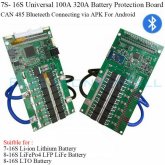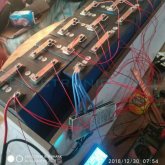For inverters larger then about a 300 watts, any ON/OFF switch within inverter will be just shutting down the electronics controlling the inverter's MOSFET's drivers. They do not use a large and expensive switch (ie. your DC breaker/switch), so capacitors are always on the battery lines coming into the inverter.
For a 3kW to 8kW inverter they typically have 7,000 to 10,000 uF's consisting of several paralleled capacitors. Throwing 48v on these caps is not that tough on caps. They are more stressed by the constant ripple current of normal inverter operation, but the large charging surge current is hard on the DC breaker if it is used to turn on inverter. It causes pitting on its contact surfaces, like little spot welding pock marks that can increase breaker switch resistance and eventually cause it to start arcing on large inverter current draw. High surge current could cause the breaker's contacts to stick together by the spot welding action and not allow the breaker to pop open for its primary safety function. And there is aways the possiblity the high surge current immediately pops the breaker back open compounding the pitting process.
Discharging time on these caps is variable depending on models of inverter. Some inverters put a couple mA current bleed resistor across these caps to accelerate their discharge time. A day or more to as little as 5 minutes might not be unexpected.
BMS with MOSFET as series cutout switch doesn't have the problems of mechanical contacts, but another good reason a solenoid contactor cutout is a bad idea. There might be a small possiblity that when the BMS switch re-engages there is enough surge current created to pop the DC circuit breaker. I would expect the series resistance of BMS MOSFET's, battery line resistance, DC breaker resistance, and any current shunt resistance is normally enough to prevent popping circuit breaker. If you have this problem your DC breaker amperage size is probably not high enough or breaker is defective.




